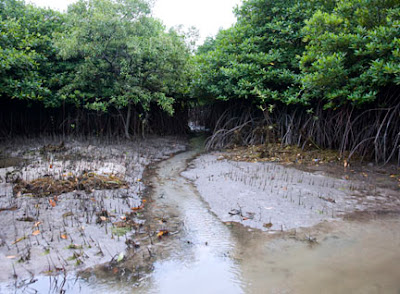And was delighted to see several patches of Seashore bat lily (Tacca leontopetaloides)!
So far, I've only seen this Critically Endangered coastal plant on Pulau Semakau. Some of the plants here were growing among large debris that somehow managed to get deep into this mangrove area. Sigh.
I had earlier already made a brief trip to see the mysterious 'white patch' that can be seen from Google Earth. Dr John Yong kindly then commented that "the 'white patch' may be the elusive hot-spring that we (with Mr Chua Keng Soon, Dr. Hugh Tan) visited many years before the construction of the landfill? Should have unique plants and especially ant plants growing epiphytically on the Lumnitzera?" So I was determined to have a closer look.
The stream running out of the 'white patch' is lined with what looks like white sand.
Here's a closer look at the 'white sand' at the bottom of the stream, compared to the mud around the stream.
The stream is generally clear of vegetation, and in some parts, surrounded by open mud.
Another view of the stream.
The stream emerges out of a large mound of white powdery fine sand.
Another look at the mound with the stream running alongside it. The stream was seeping out of the mound in a steady trickle. I couldn't find a bubbling pool and the water wasn't hot at all.
The white sandy mound is surrounded by tall trees, with an outer fringe of shorter ones.
Another view of the white mound.
In the middle of the white sand mound there were lots of Seashore pandan (Pandanus tectorius), Sea lettuce (Scaevola taccada), Bedara laut (Ximenia americana) and other common coastal plants.
There was one rather open patch of mangroves near the white sand area, but there were lots of mangrove seedlings growing there. Perhaps the gap was formed when a tree fell over and died? I didn't manage to find a pool of water near the white mound.
Some of the short trees growing near the 'white sand' mound had discoloured leaves. This was seen in various mangrove species including Api-api putih (Avicennia alba), Chengam (Scyphiphora hydrophyllacea), Bakau minyak (Rhizophora apiculata), Perepat (Sonneratia alba).
But most of the trees here seemed healthy and happy. I saw a furiously blooming Bakau pasir (Rhizophora stylosa) and Tumu (Bruguiera gymnorrhiza). There were also many healthy trees of other common species.
There were several large magnificent Tengar putih (Ceriops tagal).
I came across what seems to be a Nyireh batu (Xylocarpus moluccensis) as it didn't have peeling bark.
I only managed to sight one young Teruntum merah (Lumnitzera littorea) near the edge of the forest. I didn't manage to see any strange epiphytes during this brief trip. I guess I was too distracted by the otter that I saw earlier! I'll have to come back and explore deeper in the mangroves.
I was on Pulau Semakau today with a team from Butterfly Circle who have kindly agreed to do another survey of butterflies in the grasslands, forests and mangroves here. As usual, BC folks bring sunny weather and equally sunny company!
Here's the team after a long hot day of exploration, just before we head home.
Oh, kayakers heading past Semakau Landfill towards Pulau Hantu. Is that you Moira and friends? These brave folks kayak to visit many of our southern shores. Amazing!
More about the otter I saw today!
Other posts about this trip
- James shares about some of the beautiful and intriguing insects and spiders seen in Semakau's forested area.
- Federick shares awesome photos and stories about butterflies and flowers and other critters.





















